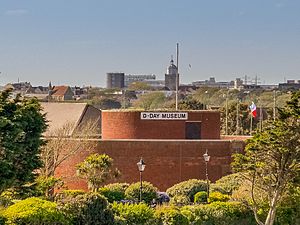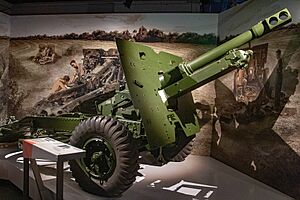The D-Day Story facts for kids
The D-Day Story is a museum in Southsea, Portsmouth, in the United Kingdom. It tells the exciting and important story of the D-Day landings in Normandy, France, during World War II. This huge military plan was called Operation Overlord.
The museum first opened in 1984. Queen Elizabeth The Queen Mother was there for the opening. In 2018, it was updated with new exhibits and reopened with its new name, The D-Day Story.
Contents
What Can You See at the Museum?
The museum tells the story of D-Day in three main parts:
- Preparation: Learn how the Allied forces got ready for the biggest sea invasion in history.
- D-Day and the Battle of Normandy: Discover what happened on the day of the landings and in the battles that followed.
- Legacy: See how D-Day is remembered today and explore a special artwork called the Overlord Embroidery.
The Overlord Embroidery
One of the most famous exhibits is the Overlord Embroidery. It was created to honor everyone who took part in D-Day. It is a huge piece of needlework that is 272 feet (83 metres) long!
It took twenty expert needleworkers seven years to finish this amazing artwork. The embroidery is made of 34 panels that show the story of the invasion, like a giant comic strip made of thread. You can also watch films of veterans sharing their own stories from the war.
Amazing Vehicles and Exhibits
A ticket to The D-Day Story also lets you climb aboard the LCT 7074. This is a real landing craft tank, a special boat used to carry tanks onto the beaches. It is the very last one of its kind that took part in the D-Day landings.
On the LCT 7074, you can explore the deck where tanks were kept. You can see a Sherman Grizzly tank and a Churchill Crocodile tank, which had a flamethrower.
The museum's collection also includes other cool vehicles:
- A Sherman BARV, a waterproof tank designed to rescue other vehicles that got stuck on the beaches.
- A DUKW, a special truck that could drive on both land and water.
Inside the museum, you can see a replica of a small boat called a Landing Craft Assault. There are also models of rooms from the 1940s, like an operations room where plans were made and a family's living room with an Anderson air-raid shelter.
A Fresh Look for the Museum
In 2017, the museum closed for a year to be updated. This £5 million project helped protect the exhibits and add new ones.
One of the new items is very small but very important: the "pencil that started the invasion." This is the actual pencil that a naval officer, Lt. Cdr. John Harmer, used to sign the order for ships to sail to Normandy. This single signature set a key part of the D-Day invasion in motion.



